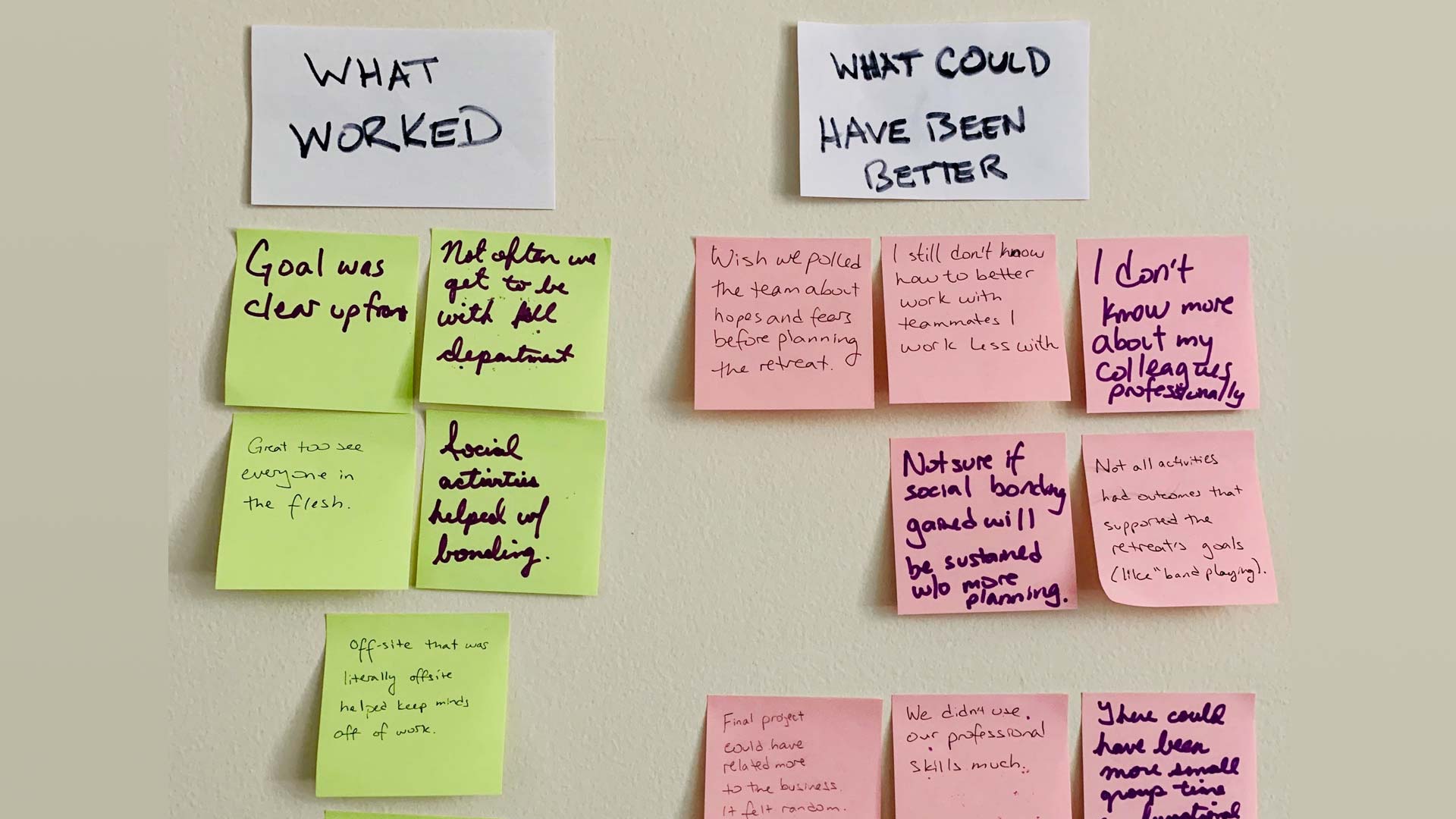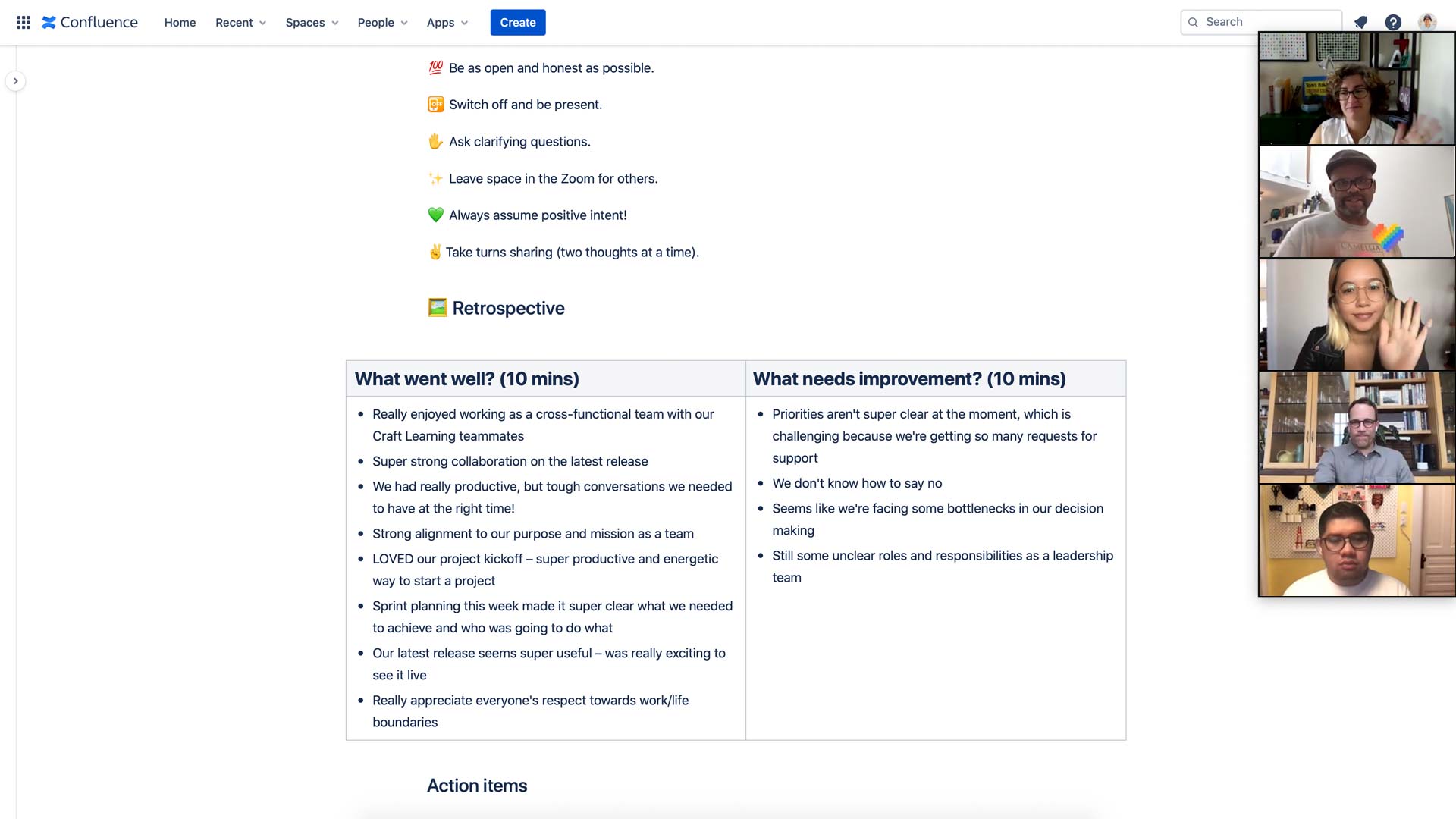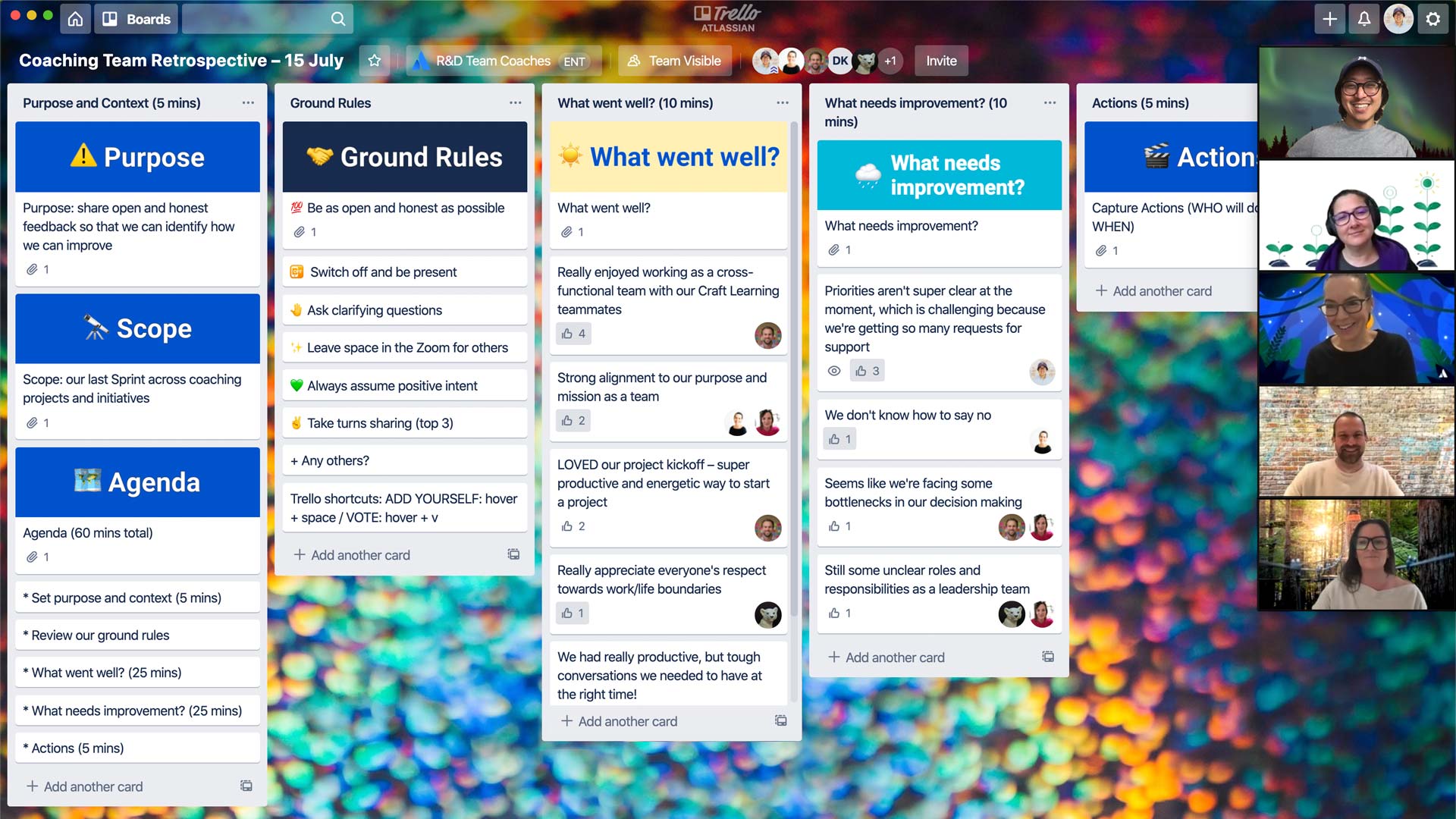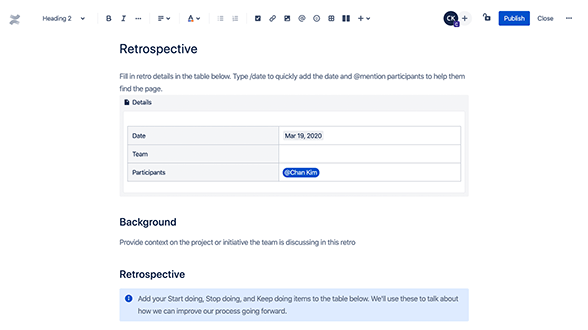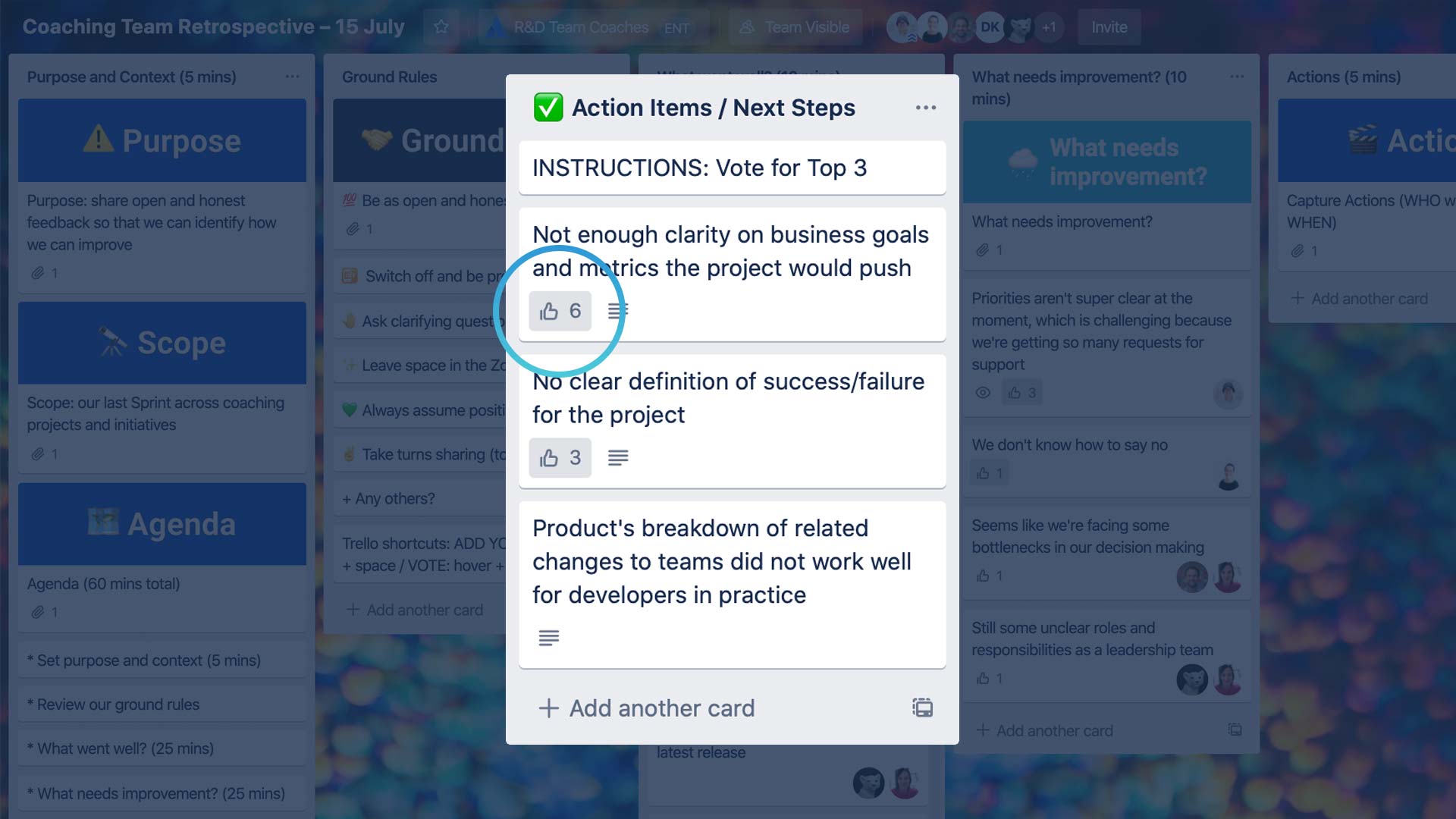Sprint-Retrospektiven
Eine Sprint-Retrospektive gibt dir die Möglichkeit, deinen letzten Sprint zu überprüfen und Verbesserungen für zukünftige Sprints vorzunehmen. Diese Treffen sind unerlässlich, weil die regelmäßige Bewertung und Verbesserung der Prozesse zu qualitativ hochwertigen Ergebnissen und weniger Hindernissen führt.
In diesem Leitfaden erfährst du, was eine Sprint-Retrospektive ist, warum sie wichtig ist und wie du erfolgreiche Sprint-Reviews durchführen kannst, um dein Team effektiver zu machen.
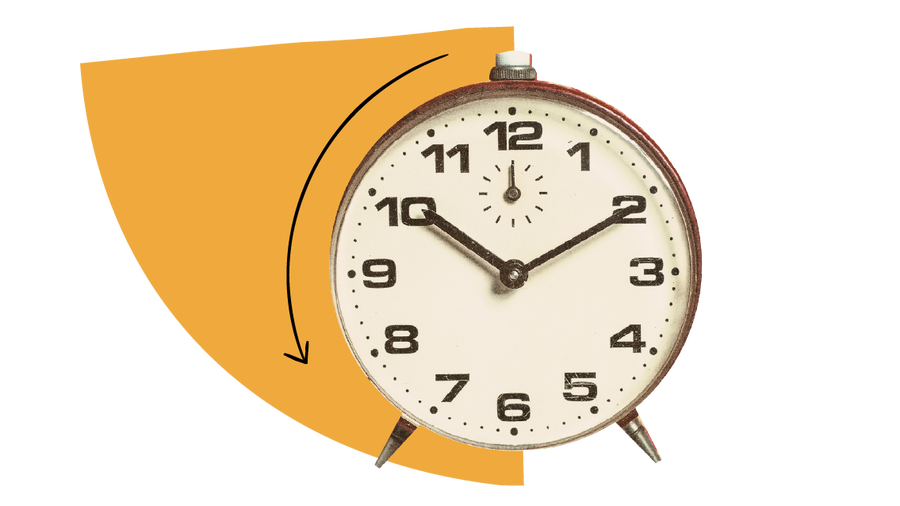
Vorbereitungszeit
15 Min.
LAUFZEIT
60 Min.
Teilnehmer
4–8
KURZZUSAMMENFASSUNG
- Feiere, was im letzten Sprint gut gelaufen ist.
- Diskutiere, was nicht so gut gelaufen ist oder besser hätte sein können.
- Lege fest, wie du im nächsten Sprint Verbesserungen vornehmen kannst.
- Verwende KI, um Einblicke zusammenzufassen, Erkenntnisse daraus abzuleiten und die Entwicklung umsetzbarer Schritte zu erleichtern.
DAS BRAUCHST DU
- Meetingraum oder Videokonferenz mit Bildschirmübertragung
- Tool für die digitale Zusammenarbeit (siehe Vorlagen)
- Optional: physisches Whiteboard, Marker, Haftnotizen und Timer
Durchführen einer 4L-Retrospektive
Denke über vergangene Sprints nach, um Verbesserungen für die Zukunft vorzunehmen.
Was ist eine Sprint-Retrospektive?
Eine Sprint-Retrospektive ist eine Überprüfung, die nach einem Sprint durchgeführt wird und eine Schlüsselrolle in der Agile-Methode spielt. Bei einer Sprint-Retrospektive soll festgestellt werden, was gut gelaufen ist und wo Probleme auftraten, und es werden Bereiche mit Verbesserungspotenzial ermittelt.
Regelmäßige Überprüfungen sind ein wesentlicher Bestandteil der Teamarbeit. Wenn du nachvollziehen kannst, was funktioniert und was nicht, kannst du agile Prozesse verbessern, um deinen nächsten Sprint zu vereinfachen.
Durch diese KI-Unterstützung bei der Suche von Dokumentation zum Sprint, beim Zusammenfassen von Einblicken und bei der Entwicklung von umsetzbaren Schritten aus diesen Einblicken gewinnen Sprint-Retrospektiven an zusätzlichem Wert.
Wer sollte an einer Sprint-Retrospektive teilnehmen?
An einer Sprint-Retrospektive sollten der Produktinhaber, das Scrum-Team, der Scrum Master, die Stakeholder und Rovo beteiligt sein.
Bei einer Sprint-Retrospektive sollten Beteiligte mit vielen unterschiedlichen Perspektiven einbezogen werden. Alle können gemeinsam den letzten Sprint analysieren und feststellen, welche Änderungen vorgenommen werden müssen, bevor der nächste Projektabschnitt beginnt.
Wie oft solltest du eine Sprint-Retrospektive machen?
Retrospektiven funktionieren am besten, wenn sie am Ende eines Sprints gemacht werden. Wenn deine Sprints kurz (etwa eine Woche) sind, könnte es sinnvoller sein, nach jedem Sprint eine Retrospektive durchzuführen.
Wie lange sollten Sprint-Retrospektiven dauern?
Die Länge einer Sprint-Retrospektive kann je nach Dauer des Sprints variieren. Sie kann kurz (45 Minuten) oder lang (3 Stunden) sein. Gib deinem Team genug Zeit und Raum für ein zielführendes Gespräch. Wenn du im Vorfeld gründlicher arbeitest, sparst du am Ende Zeit und erzielst auf lange Sicht bessere Ergebnisse.
Was sind die Hauptvorteile von Sprint-Retrospektiven?
Sprint-Retrospektiven helfen deinem Team, aus der Vergangenheit zu lernen und sich für die Zukunft besser aufzustellen, was zu optimierten Scrum-Sprints und einem besseren Endergebnis führt.
Studien zeigen, dass Retrospektiven Teams vor allem bei Folgendem helfen:
- Kontinuierliche Verbesserung
Für Wachstum ist es entscheidend, einen Aktionsplan zu erstellen und ihn in zukünftigen Treffen weiterzuverfolgen. - Verbesserung der Selbstreflexion im Team
Selbstreflexion ist "das Ausmaß, in dem ein Teammitglied kollektiv über die Ziele, Strategien und Prozesse des Teams nachdenkt und sie an aktuelle oder erwartete Umstände anpasst."
Teams mit einem höheren Maß an Selbstreflexion sind innovativer, erkennen eher Probleme und Chancen, können sich an Änderungen anpassen und neue Ideen effektiver umsetzen.
Höhere Selbstreflexion geht einher mit:
- Bessere Entscheidungsfindung
- besserer Problemlösung
- effektiverer Strategieumsetzung
- verstärktem Lernen im Team
- höherer Innovationsfähigkeit
-
bessere Anpassungsfähigkeit an Veränderungen
Weitere Studien bestätigen, dass Selbstreflexion Teams hilft:
- Informationen gründlicher zu verarbeiten
- Fehler und Fehlschläge zu reduzieren
- schneller und flexibler auf Veränderungen reagieren
Ideen für Sprint-Retrospektiven
Sprint-Retrospektiven mögen auf den ersten Blick einschüchternd wirken, sind aber eigentlich relativ simpel. Du kannst eine Vorlage für eine Sprint-Retrospektive verwenden oder die fünf Schritte befolgen, die in dieser Anleitung aufgeführt sind. Solange du Feedback einholst und es nutzt, um Erkenntnisse zu gewinnen und Änderungen umzusetzen, bist du auf dem richtigen Weg.
Jede Sprint-Retrospektive beginnt mit einem erfolgreichen Sprint. Jira bietet mehrere wichtige Funktionen, die dir helfen können, erfolgreiche Sprints zu organisieren, darunter:
- Backlogs: Backlogs ermöglichen es dir, alle Arbeiten im Zusammenhang mit einem Projekt oder einer Initiative aufzulisten. Du kannst diese Arbeit in einzelne Sprints aufteilen – die normalerweise 2 Wochen dauern.
- Boards: Mit Jira-Boards kannst du dein großes Projekt in überschaubarere Teile aufteilen, sodass du deine Sprints planen und sicherstellen kannst, dass du schneller zu Ergebnissen kommst.
- Zeitleisten: Zeitleisten stimmen dein Team mit den Stakeholdern ab und bieten einen Überblick über den Projektzeitplan mit den zugewiesenen Aufgabenelementen, Abhängigkeiten und Releases.
Jira macht es Agile-Teams einfach, Sprints zu visualisieren, zu verfolgen und zu verwalten. Mit Jira kannst du deinen nächsten Sprint optimieren, um fristgerechte Ergebnisse sicherzustellen. Teste Jira Scrum Boards und finde heraus, wie Jira dir helfen kann, dein Agile-Team zu optimieren.
1. Den Ton vorgeben
Geschätzte Dauer: 5 Minuten
Retrospektiven sind Teil der Sprintplanung. Das Ziel ist, verschiedene Rückmeldungen und Meinungen zu sammeln, um die Abläufe und Ergebnisse zu verbessern. Verwende eine unserer vorgefertigten Vorlagen, um den Vorgang zu vereinfachen.
Halte die Teilnehmer zu Beginn des Meetings an, während der gesamten Sitzung offen und konstruktiv ihre Gedanken mitzuteilen und sich auf Verbesserungen zu konzentrieren, anstatt auf Schuldzuweisungen. (Das ist wesentlich für den Aufbau psychologischer Sicherheit und einer Kultur ohne Schuldzuweisungen.) Füge deinem Meeting zur Unterstützung Loom AI hinzu. Die App übernimmt das Mitschreiben. Dadurch kann sich dein Team dann ganz auf die Retrospektive konzentrieren.
Ermuntere dein Team außerdem, mit Rovo als Partner zum Gedankenaustausch zu chatten, wenn es Bedenken hinsichtlich des Tonfalls oder der Vermittlung von Feedback hat.
TIPP: SCHAFFE EINEN SICHEREN ORT
Mache deutlich, was mit den in der Retrospektive besprochenen Informationen passieren wird. Verbleiben sie in der Gruppe? Werden sie mit der Führungsebene geteilt? Wende vielleicht die Chatham House-Regel an, um eine sichere, angenehme Umgebung für die Teammitglieder zu schaffen.
2. Feedback einholen
Geschätzte Dauer: 15 Minuten
Sobald du den Ton und die Erwartungen für das Meeting gesetzt hast, kannst du das Feedback der Teammitglieder darüber einholen, wie das letzte Sprint verlaufen ist. Das kann auf vielerlei Arten umgesetzt werden, zum Beispiel:
- 💬 Offene Gruppendiskussion darüber, was gut gelaufen ist und was nicht
- 🗒️ Umfragen (auch anonym)
- ❤️ 4L-Retrospektive: Diskutiert darüber, was alle während des letzten Sprints geliebt (loved), verabscheut (loathed), gelernt (learned) und sich gewünscht (longed for) haben.
- 🙂 Das Sad-Mad-Glad-Konzept: Diskutiere, warum Teammitglieder jedes dieser Gefühle empfanden. Was war enttäuschend? Frustrierend? Aufregend und ermutigend?
- Verwende die Rovo-Suche, um relevante Seiten oder Tickets zu sammeln und Feedback in einen Kontext zu setzen.
Tipp: Ermutige die Teilnehmer zum Reden
Eines der größten Hindernisse in einer Sprint-Retrospektive ist, wenn Teammitglieder nicht genug Feedback geben. Schaffe nicht nur einen sicheren Raum, sondern lenke das Gespräch mit einfachen Diskussionsmethoden wie 4L oder "Sad, Mad, Glad". Du kannst auch versuchen, anonyme Beiträge zu sammeln.
Wenn eine Person das Gespräch dominiert, stelle Fragen in die Runde, damit alle ihre Meinung äußern können.
3. Aus Feedback Erkenntnisse ableiten
Geschätzte Dauer: 20 Min.
Achtet als Gruppe auf Muster und Trends im erhaltenen Feedback. Was haben wir gelernt? Was können wir ändern, um auf den positiven Dingen aufzubauen und negative Aspekte zu reduzieren oder zu vermeiden? Diese Erkenntnisse sind entscheidend für die Zielsetzung und den Verbesserungsprozess. Ermutige also alle, sich daran zu beteiligen.
Tipp: Achte auf Trends
Bei Sprint-Retrospektiven geht es darum, den nächsten Sprint besser zu machen, Konzentriere dich daher mehr auf Muster und Trends als auf einzelne Fehler oder Erfolge, die sich wahrscheinlich nicht wiederholen werden.
Tipp: Nimm Rovo in die Gruppe auf
Nutze den Rovo-Chat, um wichtige Muster und Trends aus dem Feedback herauszuarbeiten.
4. Maßnahmen planen
Geschätzte Dauer: 15 Minuten
Jetzt ist es an der Zeit, das Gelernte in die Tat umzusetzen. Hier kannst du anfangen, dir Ziele zu setzen und festzulegen, welche Änderungen du für zukünftige Sprints vornehmen musst.
Denke beim Dokumentieren der geplanten Änderungen und Aktionspunkte daran, Deadlines und Verantwortliche zuzuweisen, um schneller voranzukommen.
Tipp: Füge Aktionspunkte zu deiner Aufgabenliste hinzu
Anstatt die Aktionspunkte auf einem Zettel oder digital zu dokumentieren, kannst du sie auch direkt in ein System für die Sprintplanung oder das Projektmanagement wie Jira oder Trello eingeben, damit sie sofort in deine Pläne integriert sind. Das geht natürlich auch zusätzlich.
Wenn zu den Aktionspunkten Tickets oder Vorgänge vorhanden sind, füge einen Link auf der Retrospektivseite und/oder in der Aufgabenliste ein, damit der Status leicht nachvollziehbar ist.
Tipp: Nutze den KI-Chat
Wandle das Feedback, die Muster und Einblicke mit dem KI-Chat in umsetzbare nächste Schritte um.
5. Fazit
Geschätzte Dauer: 5 Minuten
Schließe deine Sprint-Retrospektive ab, indem du allen für ihre Beiträge dankst und eine Zusammenfassung der wichtigsten Erkenntnisse und Aktionspunkte mitteilst. Dann weiter zum nächsten Sprint!
Abwandlungen
Lass nicht zu, dass deine Retros zu faden, abgehakten und sinnentleerten Übungen werden. Es gibt verschiedene Möglichkeiten, Gespräche zu führen. Experimentiere und finde heraus, was in deiner Gruppe am besten funktioniert. Hier sind neun unserer Lieblingsübungen für Sprint-Retrospektiven.

Hast du noch Fragen?
Komme mit anderen Benutzern des Atlassian Team-Playbook ins Gespräch, hole dir Unterstützung oder gib Feedback.
Andere Spiele, die dir gefallen könnten
Meetings
Wöchentliche Team-Updates
Teile mit, wie die Dinge laufen – ohne ein weiteres Meeting zu vereinbaren.
Meetings
Seitenbasierte Meetings
Der optimale Ausgangspunkt für Meetings ist eine Seite, auf der der Zweck, die erwarteten Ergebnisse und die wichtigsten Diskussionspunkte angegeben werden.
Kommunikation
Benutzerhandbuch
Teile deinen Teamkollegen mit, wie sie am besten mit dir zusammenarbeiten können.
Unternehmenskultur
Gesundheitscheck für Teams
Beurteile den Zustand deines Teams und lege einen Optimierungsplan fest.
Bleibe auf dem neuesten Stand.
Melde dich für unseren Newsletter an, wenn du über neue Spiele informiert werden und Tipps für besseres Arbeiten erhalten möchtest.







